How two kids made $66m from bizarre YouTube trend

Ryan Kaji and Anastasia Radzinskaya are just your regular kids - except for the fact that they’re multimillionaires.
Eight-year-old Kaji and five-year-old Radzinskaya are YouTube stars, banking $39 million and $27 million in 2019 respectively from advertisements, sponsored content, merch sales, tours and more.
Kaji was Forbes’ top highest-paid YouTube star of 2019 - a title he earned through his successful channel ToysReview now Ryan’s World, in which Kaji literally just opens presents in front of the camera and comments on each one.
Kaji makes comments like, “This is awesome!” and plays with his toys on video.
Radzinskaya’s channel is a little different.
The Russian YouTube star, who is third on Forbes’ highest-paid YouTube stars of 2019’s list, has cerebral palsy, and initially her parents posted videos of her to the platform to track her development.
Now, Radzinskaya posts videos playing with her dad, toys and animals to the tune of catchy jingles for her 107 million subscribers.
But how has this garnered them millions of dollars?
According to Pew Research, videos featuring a child or children who appeared to be under the age of 13 received nearly three times as many views on average as other types of videos.
With millions of subscribers each, children like Kaji and Radzinskaya can make tonnes of money through advertising and merch.
One of Kaji’s videos featuring him opening and reviewing a box containing more than 100 toys from Pixar’s Cars series has more than 1 billion views - which is when management agencies began contacting him.
Now, Kaji even has his own toy and clothing lines, as well as a show on Nickelodeon and a deal with streaming service Hulu.
Radzinskaya’s most famous video garnered 767 million views, leading her to make six-figure deals with Legoland and other brands. She’s even set to launch a toy line, some mobile games and publish a book.
The ‘unboxing’ phenomenon
Unboxing videos, which literally involve someone posting a video of themselves opening packages and purchases, are a huge success - with the number of YouTube clips with “unboxing” in the headline increasing by 871 per cent since 2010.
These videos are hugely popular with viewers: a Google study even found one in five shoppers consult an unboxing video before they purchase themselves.
And it’s a figure brands are capitalising on.
Rather than standard advertising tactics, new brands are taking advantage of the “white space” surrounding exciting unboxing experiences.
Children are particularly receptive to these types of videos, Michael Rich, director and founder of the Boston Centre on Media and Child Health told a Boston radio station.
“I think kids enjoy these videos because kids enjoy Christmas and birthdays,” Rich said. “Which is, they are vicariously gaining that surprise of 'what's in it, what’s in it, what’s in it? Oh wow, that’s really cool.”
But experts and parents are worried
In January last year, the public prosecutor’s office in Brazil announced it was going to sue Google, accusing YouTube of “engaging in abusive advertising practices toward children” through toy unboxing videos.
That’s because, in Brazil, it’s illegal to advertise to children 12 and under.
But around the world, parents are concerned that their children are developing wants and needs for material things before they should.
“Ultimately you're not learning ABCs, but you're learning to want things,” Rich said.
“It feeds into the 'give me' culture.”
But parents aren’t encouraged to cut this behaviour at the stem - but rather figure out other ways to satisfy their kids’ needs.
"We need to take seriously the kids who get sucked into the Fortnite vortex or who are hooked on social media or even an unboxing video," said Rich.
"And instead of punishing, restricting, limiting, cutting it off, [we should be] understanding that it is meeting a need for them and we need to figure out how to meet it in other ways that are healthier."
YouTube is working to limit revenue possibilities for children’s channels for allegedly violating the Children’s Online Privacy Protection Act rule, and is set to ban targeted ads for kids’ content.
Make your money work with Yahoo Finance’s daily newsletter. Sign up here and stay on top of the latest money, news and tech news.
Follow Yahoo Finance Australia on Facebook, Twitter, Instagram and LinkedIn.

 Yahoo Finance
Yahoo Finance 